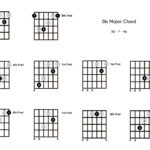For guitarists of all levels, from beginners to seasoned players, the way you hold your plectrum—or guitar pick—can significantly impact your playing. It might seem like a minor detail, but your pick grip influences your tone, control, speed, and overall playing style. If you’ve ever wondered whether you’re holding your pick correctly, or if experimenting with different grips could unlock new levels in your guitar playing, you’re not alone.
Many guitarists, even those with years of experience, find themselves revisiting this fundamental technique. Online discussions and insights from renowned players often highlight how a simple change in pick grip can lead to substantial improvements. You might have heard about techniques where the index finger curls directly parallel under the thumb, contrasting with the more common method of crossing it perpendicularly. While experimenting with these variations can indeed produce a stronger, louder tone, mastering the control, especially for smooth rhythm playing, can feel challenging.
This article will explore the essential aspects of holding a guitar plectrum effectively. We’ll delve into different techniques, discuss their pros and cons, and help you discover the grip that best suits your playing style and musical aspirations.
Understanding the Importance of Plectrum Grip
Before diving into specific techniques, it’s crucial to understand why your plectrum grip matters so much. The way you hold your pick is the primary interface between you and your guitar strings. It dictates:
- Tone: A subtle shift in grip can drastically alter your guitar’s tone, making it brighter, warmer, thinner, or thicker.
- Control: A secure and comfortable grip gives you greater control over dynamics, articulation, and the depth of pick penetration into the strings.
- Speed: An efficient grip facilitates faster and more fluid picking, essential for lead playing and intricate rhythms.
- Playing Style: Different grips are often favored by players in specific genres, reflecting the tonal and technical demands of those styles.
Finding the right plectrum grip isn’t about adhering to a rigid “correct” method. It’s about discovering what feels most natural and allows you to achieve your desired sound and playing style.
Three Main Plectrum Holding Techniques
While variations abound, there are three primary methods of holding a guitar plectrum that serve as a foundation for most players. Let’s examine each:
1. The “O” Method (or Standard Grip)
This is arguably the most common and versatile grip, often recommended for beginners and favored by players across genres. In this method, you form an elongated “O” shape with your thumb and index finger. The plectrum is held between the side of your thumb and the side of your index finger’s first knuckle.
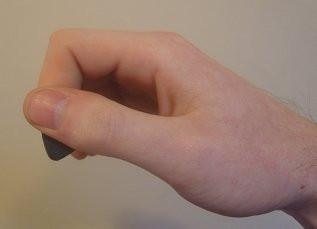 Image of the “O” method pick grip from the player’s perspective, showing the elongated ‘O’ shape formed by the thumb and index finger.
Image of the “O” method pick grip from the player’s perspective, showing the elongated ‘O’ shape formed by the thumb and index finger.
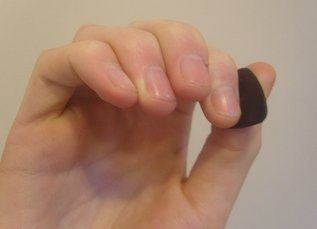 Close-up image of the “O” method pick grip, highlighting the contact points between the thumb, index finger, and plectrum.
Close-up image of the “O” method pick grip, highlighting the contact points between the thumb, index finger, and plectrum.
Pros:
- Balance of Control and Tone: Offers a good compromise between precise control and a full, balanced tone.
- Versatility: Suitable for various playing styles, from strumming to lead work.
- Adaptability: Allows for subtle adjustments in angle and pressure.
Cons:
- Can be too rigid for some: Some players may find it less flexible for certain techniques.
2. The “Pinch” Method (or Flat Grip)
The “pinch” method involves using the flat of your index finger to grip the plectrum, rather than the side. This technique generally offers more flexibility and is often favored by players who use lighter gauge picks and focus on strumming.
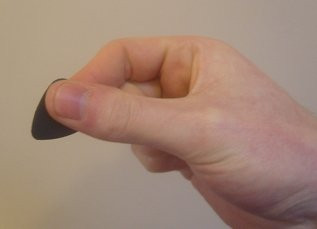 Image showcasing the “pinch” method pick grip from the player’s view, emphasizing the flat index finger and the pinched plectrum.
Image showcasing the “pinch” method pick grip from the player’s view, emphasizing the flat index finger and the pinched plectrum.
 Detailed image of the “pinch” method, illustrating how the plectrum is held between the thumb and the flat surface of the index finger.
Detailed image of the “pinch” method, illustrating how the plectrum is held between the thumb and the flat surface of the index finger.
Pros:
- Increased Flexibility: Allows for greater pick flexibility, ideal for strumming and lighter playing.
- Softer Tone: Can produce a softer, more rounded tone.
Cons:
- Less Control for Precision Picking: May offer less control for fast, articulate lead playing or aggressive rhythm.
- Not ideal for heavy gauge picks: Can feel less secure with thicker picks.
3. The “Fist” Method (or Bluegrass Grip)
Often called the “fist” method, this grip is characterized by a more closed hand position. The index finger curls more directly parallel under the thumb, creating a firmer hold. This technique is frequently favored by bluegrass players and those using heavier gauge picks, aiming for a strong, powerful tone.
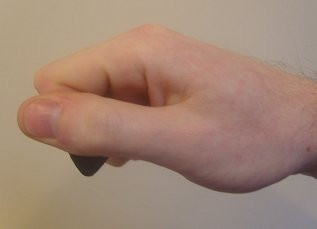 Image demonstrating the “fist” method pick grip from the player’s perspective, highlighting the curled index finger and firmer hand position.
Image demonstrating the “fist” method pick grip from the player’s perspective, highlighting the curled index finger and firmer hand position.
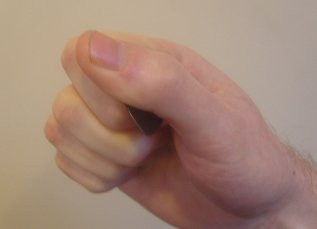 Close-up image of the “fist” method, showing the index finger curled parallel under the thumb for a secure and powerful grip.
Close-up image of the “fist” method, showing the index finger curled parallel under the thumb for a secure and powerful grip.
Pros:
- Powerful Tone: Facilitates a stronger, louder, and more aggressive tone.
- Good for Heavy Gauge Picks: Provides a secure grip for thicker, heavier picks.
- Suitable for certain genres: Well-suited for bluegrass, rock, and other genres demanding a strong attack.
Cons:
- Reduced Dexterity: Can feel less flexible and nuanced compared to other grips.
- Steeper Learning Curve: May require more practice to master control and finesse, especially for rhythm playing.
Experimenting with Pick Gauge and Grip
The “best” way to hold a plectrum isn’t fixed—it’s a dynamic element that interacts with your pick gauge, playing style, and musical preferences. Experimentation is key to finding your optimal combination.
Pick Gauge Considerations:
- Lighter Gauges (.46mm – .73mm): Often work well with the “pinch” or “O” method, offering flexibility for strumming and a brighter tone.
- Medium Gauges (.73mm – 1.0mm): Versatile and suitable for the “O” method, providing a balance for both rhythm and lead playing.
- Heavy Gauges (1.0mm+): Frequently paired with the “fist” method for a powerful tone and secure grip, especially for genres like bluegrass or heavier rock styles.
Finding Your Ideal Combination:
- Gather a Variety of Picks: Obtain picks of different gauges and materials to experiment with.
- Try Each Grip with Different Gauges: Systematically try each of the three main grips with various pick thicknesses.
- Play Different Styles: Practice strumming, rhythm patterns, scales, and licks in genres you enjoy to assess how each combination feels and sounds.
- Pay Attention to Comfort and Control: Prioritize grips that feel comfortable and allow you to maintain control over your playing, even at faster tempos.
Adapting Your Grip to Different Styles
Your ideal plectrum grip might even evolve depending on the musical style you’re playing. For example:
- Rhythm Guitar: For funk or intricate 16th-note rhythms, a lighter pick and a more flexible grip (like the “pinch” or a looser “O” method) can facilitate smooth strumming patterns.
- Lead Guitar: For fast, articulate lead lines, a more secure grip (like a tighter “O” method or even the “fist” for certain styles) can provide the necessary control and attack.
- Genre Considerations: Bluegrass players often favor the “fist” method for its powerful tone and suitability for fast, precise picking. Blues players might use a more relaxed “O” method for expressive bends and vibrato.
Conclusion: Personal Preference and Consistent Practice
Ultimately, the “best” way to hold a plectrum for guitar is the one that feels most natural and enables you to achieve your musical goals. Experiment with the different methods, pick gauges, and adapt your grip to different styles. However, avoid getting bogged down in endless experimentation. Once you find a grip that works reasonably well, stick with it and focus on consistent practice. Muscle memory and developing your ear are far more crucial than constantly chasing the “perfect” grip.
So, explore, experiment, and then get back to playing and making music!


